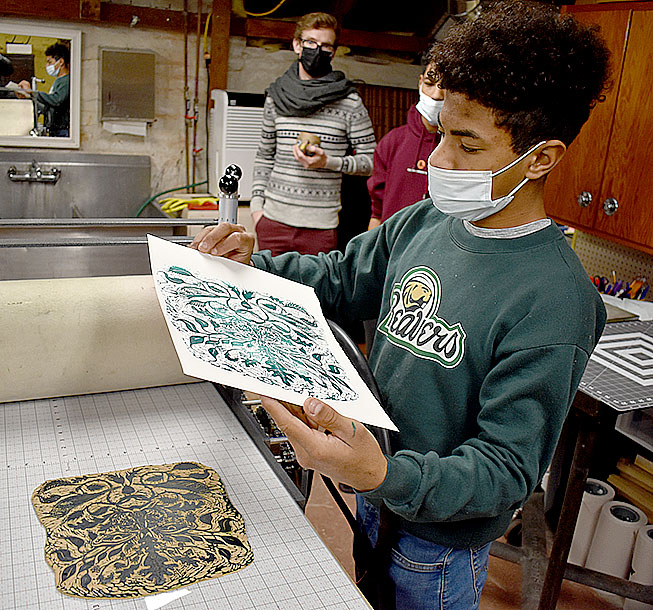Grand artist demonstrates the art of printmaking

15-year-old Luke Engle tries his hand at monoprinting during a demonstrationg in The Grand’s Celler Press.
NEW ULM — Printmaking artist Rachel James returned to The Grand’s Cellar Press studio Saturday to lead a demonstration on monoprinting.
James has worked as a printmaking teacher at Gustavus Adolphus College and Minnesota State University. As an artist, her focus is mostly on etching, but back in September she took part in The Grand’s artist-in-residence program and completed a large linoleum block print in the Celler Press studio space. Her demonstration on Saturday was a follow to the work she did in September.
As part of the demonstration, James went into detail on the process of creating a relief print and went into the history of printmaking as an art form.
In general, printmaking involves applying ink to the raised surface of a material and pressing the inked material onto a canvas or other type of media. James said printing is a lot like using an ink stamp. A common printmaking project done with young children is the potato stamp. One end of a potato is cut to create a symbol or image. This image is covered with ink and the user now has a simple ink stamp.
Throughout history, different materials have been used to create print blocks. Wood blocks were some of the most popular. James’ recent work in the Celler Press used a large linoleum block. Linoleum is strong but is easier to cut than wood. Her relief cut features various regional wildlife including frogs, a beaver and a crane. She also places a human skull in the work symbolizing the threat to animal life.

Artist Rachel James shows examples of the different materials used for printng
Once a printing block has been created, the image can be copied on a variety of materials. Paper is the most common, but other materials can be used. James said because her work had an environmental message, she was careful about the types of material she printed on.
She showed examples of prints made onto different fabric materials. James tried to find waste or recycled materials. Thrift stores had a variety of fabrics that could be used for printing.
Depending on the type of fabric used, the print might last longer than a paper print. Temperature and the elements damage a paper print, but certain fabrics will hold up longer.
James experimented with cellophane. Since the material was transparent, the printing process left a unique image on the reverse side.
James also gave a hands-on demonstration on how individual prints were made using one of the printing presses. Using a woodblock carving, those attending the demonstration could apply the ink and run it through the press to create unique prints.
As an example, James ran a print with leaves and part of an orange bag through the press. The leaves and bag blocked some of the ink from transferring to the copy, creating organic outlines.
Using different ink colors and different materials in the press, there was an infinite number of designs that could be created.
James described printmaking as one of the most accessible froms of art. The creation of the printing press and movable type allowed for greater forms of communication and an increase in literacy. It is for this reason, many artists remain passionate for the art form.
Those attending the demonstration also got a tour of The Grand’s Cellar Press that contains several styles of the printing press. Several prints created in the Celler Press are available to purchase in the Grand’s gift shop.
- 15-year-old Luke Engle tries his hand at monoprinting during a demonstrationg in The Grand’s Celler Press.
- Artist Rachel James shows examples of the different materials used for printng






